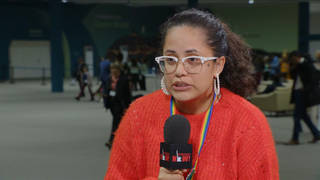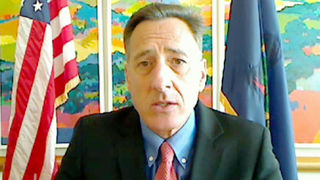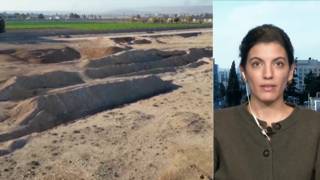
Related
Guests
- Arnie Gundersenchief engineer of energy consulting company
Fairewinds Associates and a former nuclear power industry executive.
Workers at the crippled Fukushima Daiichi nuclear power facility in Japan have started to pump radioactive water from a leaking reactor into a makeshift storage area—an effort they say is a crucial step toward easing the nuclear crisis. The Tokyo Electric Power Company says it will take six to nine months to achieve a “cold shutdown.” Meanwhile in the United States, the owners of the Vermont Yankee nuclear power plant have filed a federal lawsuit on Monday against a state law that gives the Vermont state legislature veto power over operation of the reactor when its current license expires next March. We speak with longtime nuclear expert Arnie Gundersen in Burlington, Vermont. [includes rush transcript]
Transcript
AMY GOODMAN: Today, workers at the crippled Fukushima Daiichi nuclear plant in Japan started to pump radioactive water from a leaking reactor into a makeshift storage area, an effort they say is a crucial step toward easing the nuclear crisis. About 25,000 tons of contaminated water has collected in the basement of Unit 2. Moving it will help restore the vital cooling systems knocked out in the March 11th tsunami.
The Tokyo Electric Power Company, TEPCO, remained optimistic Sunday it can bring down radiation at the damaged plant in three months and achieve what it called a “cold shutdown” of the facility in six to nine months. A cold shutdown would core temperatures under 100 degrees. TEPCO officials acknowledged setbacks, such as another power outage, could delay a plant shutdown.
Meanwhile, here in the United States, owners of the Vermont Yankee nuclear plant have filed a federal lawsuit against a state law in Vermont that gives the Vermont legislature veto power over operation of the reactor when its current license expires next March. We’ll speak with the chief whistleblower now, from Vermont Yankee, Arnie Gundersen. He says Vermont Yankee, which went into operation in 1972, is exactly like ones in Japan. He’s a nuclear engineer who coordinated projects at 70 nuclear power plants around the United States. He’s joining us from Burlington, Vermont.
Arnie Gundersen, thanks for coming back to Democracy Now! Can you assess the situation in Japan? We don’t have much time. And talk about what’s happening in Vermont right now, because even as this nuclear crisis unfolds in Japan, President Obama is pushing for nuclear power plants to be built in this country after decades of them not being built here.
ARNIE GUNDERSEN: Well, the plants at Fukushima are identical to Vermont Yankee, Oyster Creek, Pilgrim. There’s about 20 different plants here in the States that are identical to Fukushima. And they — and, of course, President Obama basically said that they’re different than we are, and our plants are safe. Here in Vermont, the day after Fukushima, the Nuclear Regulatory Commission gave Vermont Yankee a 20-year license extension, despite the fact that Fukushima had just had an accident. On top of that, though, there’s an issue where here in Vermont we have the legislative approval for Vermont Yankee to move forward beyond its end of life, which is 2012. And the legislature said no last year. And just yesterday, the owner of Vermont Yankee, Entergy, sued the state of Vermont, saying that we had no right to make that decision.
AMY GOODMAN: On what grounds? On what grounds, Arnie Gundersen —
ARNIE GUNDERSEN: Oh, on what grounds.
AMY GOODMAN: — does the Vermont legislature not have the right to make this decision?
ARNIE GUNDERSEN: I believe the legislature does have the right. Back in 2002, when Entergy bought the plant, they signed an agreement saying that, in fact, Vermont did have the right to terminate their license in 2012. We cannot do it for safety reasons. That’s clearly the Nuclear Regulatory Commission’s jurisdiction. But the position of the state is that it’s not going to be a reliable source of power moving forward. And based on reliability and economics, the state decided that it did not want to grant the license for 20 more years.
AMY GOODMAN: You were an expert witness during the investigation of the 1979 Three Mile Island accident. You never actually worked at Vermont Yankee, is that right? But what was your relationship with it?
ARNIE GUNDERSEN: I was a senior vice president of a company that provided services throughout the industry, including Vermont Yankee, and actually provided the nuclear fuel racks that were used in this design. So, that’s one of the problems at Fukushima, is this Mark I design has its nuclear fuel racks way up in the very top of the building. And it creates an earthquake problem and also a fire and terrorist hazard. And all of those can occur, as well, at Vermont Yankee.
AMY GOODMAN: Can you talk about TEPCO saying that they were optimistic that they could bring down radiation at the damaged plant and go to a cold shutdown of the facility in six to nine months? That’s in Japan.
ARNIE GUNDERSEN: It’s a really optimistic schedule. It’s a really optimistic schedule. The cold shutdown means that there’s no more boiling in the reactor, and it’s at atmospheric pressure. And in order to do that — there are cooling systems that are in those buildings that have exploded, so they’re actually trying to build a new system outside of those buildings, and they’re frantically trying to procure heat exchangers and pipes and pumps and valves —- this in the middle of many seismic aftershocks. I think the biggest concern with their schedule is twofold. One is aftershocks are likely, and these buildings are damaged, so a severe aftershock could really set them back or, more importantly, release a lot of radiation. And the second problem is their -—
AMY GOODMAN: Will radiation be leaking for the six to nine months?
ARNIE GUNDERSEN: Radiation is leaking every day now, both liquid into the ocean and also airborne. When you see those clouds of smoke coming out of the unit, that’s not steam, that’s radioactive steam. So, they’re releasing radioactivity as a airborne, and also, probably more important right now is Unit 2, the reactor has a hole in it, and the containment has a hole in it. So they’re pouring water in the top, and it’s running out the bottom. And it’s what’s causing all of this enormous amount of high-level radioactive waste.
AMY GOODMAN: Arnie Gundersen, we’re going to have to leave it there. I thank you very much for being with us, nuclear whistleblower speaking to us from Burlington, Vermont.












Media Options